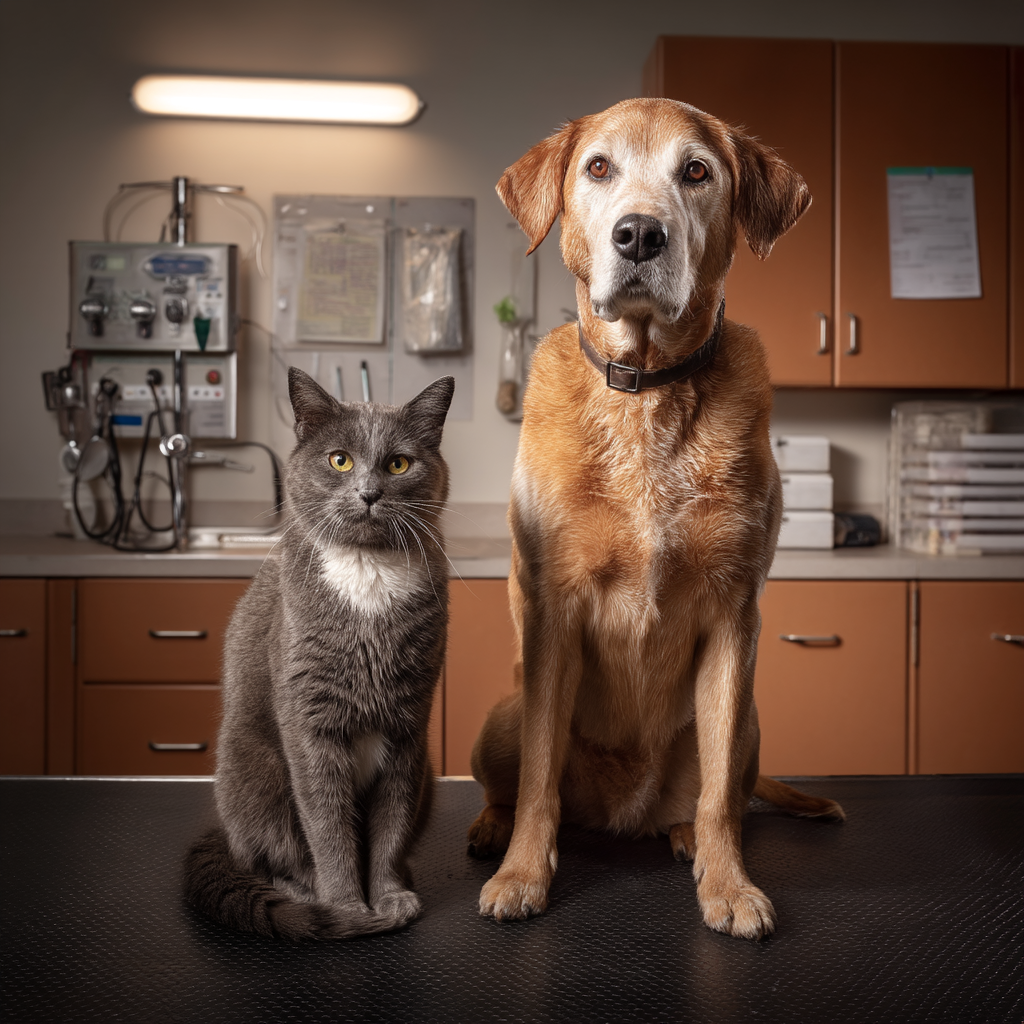
Understanding Feline and Canine Diabetes Through Veterinary Glucose Monitoring
Share
To understand feline and canine diabetes, veterinary monitoring of glucose levels is essential. Cats often develop type 2 diabetes with insulin resistance, while dogs usually have type 1, lacking insulin production. Recognize early symptoms, such as increased thirst and weight loss. Some breeds, like Burmese cats and Samoyeds, are predisposed to this condition. Regular glucose monitoring guides insulin dosages and diet, improving health outcomes. Advanced technology provides accurate, real-time data. Continue for more on managing your pet's diabetes effectively.
The Prevalence of Diabetes in Cats and Dogs
Diabetes is a significant health concern affecting both cats and dogs, although its prevalence varies between the two species. In cats, diabetes mellitus is mainly type 2, where insulin resistance plays a significant role. Conversely, dogs are more frequently diagnosed with type 1 diabetes, characterized by a lack of insulin production. Certain breeds have a predisposition to diabetes, which affects their prevalence. For instance, Burmese cats show a higher incidence, while breeds like the Samoyed and Miniature Schnauzer are more susceptible among canines. Understanding these diabetes types and breed predispositions is essential for developing targeted prevention and management strategies. By leveraging innovative veterinary glucose monitoring, you can enhance early detection and improve outcomes in managing diabetes in both feline and canine patients.
Recognizing Symptoms and Risk Factors
How can you identify the early signs of diabetes in your pet? Start with symptom recognition. Look for increased thirst, frequent urination, unexplained weight loss, or changes in appetite. These signs might indicate diabetes onset. It's vital to monitor these symptoms in your pet’s routine to guarantee prompt intervention.
Understanding risk factors is equally important. Obesity, age, and breed predisposition can elevate diabetes risk. For instance, Burmese cats and certain dog breeds, such as Samoyeds, show a higher susceptibility. Regular veterinary check-ups and glucose monitoring are necessary for pets with these risk factors.
Implementing technology-driven solutions can aid in early detection and management. Stay informed and proactive to foster your pet’s well-being. Don’t wait—early recognition and intervention can significantly improve outcomes.
How Diabetes Affects Pets' Health
When a pet develops diabetes, it can profoundly impact their overall health and quality of life. Hyperglycemia leads to symptoms such as increased thirst, urination, and weight loss, undermining their well-being. Effective management hinges on dietary management and insulin therapy. You’ll need to adjust their diet to regulate blood sugar levels, focusing on high-fiber, low-carbohydrate meals. This dietary management minimizes glucose spikes, optimizing their metabolic function. Concurrently, insulin therapy is essential. Administering precise insulin doses helps mimic natural pancreatic function, stabilizing blood glucose. These interventions collectively reduce the risk of diabetic complications such as neuropathy and cataracts. By integrating these strategies, you can improve your pet’s health and foster a longer, more active life despite diabetes.
The Role of Veterinary Glucose Monitoring
While managing diabetes in pets, veterinary glucose monitoring plays a critical role in guaranteeing effective treatment. You need to understand glucose fluctuations to tailor interventions accurately. Consistent monitoring provides invaluable data, allowing you to adjust insulin dosages and dietary plans effectively. In recent years, advanced monitoring technology has revolutionized diabetes management in pets. Devices now offer real-time data, which helps you make informed decisions quickly. This technology not only improves the accuracy of glucose readings but also minimizes stress for you and your pet. By leveraging these innovations, you can optimize treatment protocols, reducing the risk of complications. Ultimately, embracing cutting-edge monitoring technology guarantees a proactive approach to managing your pet’s diabetes, securing their health and longevity.
Techniques for Monitoring Blood Sugar Levels
Monitoring blood sugar levels in pets with diabetes is an essential aspect of effective disease management. You’ll find that blood glucose testing is typically performed using portable glucometers, which require small blood samples and provide rapid results. These devices are easy to use and have been proven reliable in clinical settings. Continuous monitoring systems are emerging as innovative tools, offering real-time data and reducing stress for both pets and owners. These devices are less invasive and can detect trends in glucose levels, allowing for proactive management. By using both traditional testing and continuous monitoring, you can better control your pet’s diabetes, ultimately improving its quality of life. Embrace these advancements to guarantee your pet receives the best care possible.
Developing Effective Treatment Plans
1. Dietary adjustments
2. Insulin administration
3. Glucose monitoring
4. Exercise planning
You'll be better equipped to manage your pet's diabetes effectively.
Supporting a Diabetic Pet's Lifestyle
To effectively manage your pet's diabetes beyond treatment plans, integrating supportive lifestyle changes is vital. Implementing a robust dietary management plan is essential; consider a balanced diet tailored to stabilize your blood glucose levels. Consult your veterinarian to determine the appropriate nutritional choices for your pet’s needs, which may include high-protein, low-carbohydrate formulations. Consistency in meal timing supports ideal glucose control.
Incorporating exercise routines can enhance insulin sensitivity, aiding in better glucose regulation. Design an activity plan that matches your pet’s physical capabilities and preferences, ensuring regular engagement without overexertion. Monitor your pet's response to both dietary and exercise interventions, adjusting as necessary to achieve the best outcomes. By embracing these innovative strategies, you’ll significantly contribute to your pet’s quality of life and long-term health.
Conclusion
You're now equipped to tackle the colossal challenge of managing feline and canine diabetes. Recognizing symptoms early and leveraging veterinary glucose monitoring can transform your pet's life. With pinpoint accuracy, these techniques enable you to develop truly remarkable treatment plans. Supporting your diabetic pet's lifestyle isn't just a task; it's a mission of epic proportions. Embrace this journey with the fervor of a seasoned expert, and watch your pet thrive against all odds.
